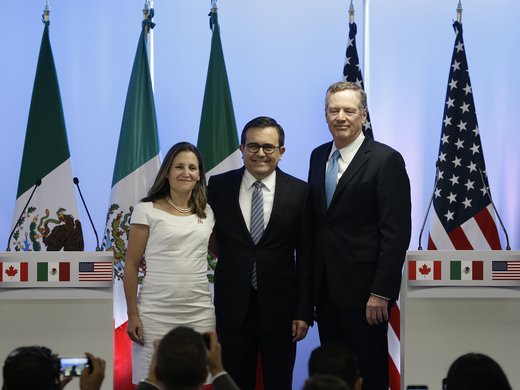In August, Canada, the United States and Mexico began a renegotiation of the North American Free Trade Agreement (NAFTA) in which everything is on the table, including the treaty’s environment-related provisions. Judged by the objective of protecting and enhancing the environment and conserving natural resources, is the revised NAFTA likely to be better or worse?
NAFTA currently includes two sources of environment-related provisions: those in the agreement itself and those in a legally distinct side agreement — the North American Agreement on Environmental Cooperation (NAAEC). The latter, which came into force at the same time as NAFTA, created a separate Commission for Environmental Cooperation (CEC) under the jurisdiction of the three environment ministers, responsible for supporting “cooperation among the NAFTA partners to address environmental issues of continental concern, including the environmental challenges and opportunities presented by continent-wide free trade.”
If a revised NAFTA follows trends seen in recent regional trade agreements (RTAs), all environment-related provisions will be moved to within the agreement, the CEC will be replaced with much weaker institutions, and the agreement will lose one of the CEC’s key strengths — the ability to focus on environmental matters not directly related to trade.
A revised NAFTA is likely to follow the lead of modern RTAs, in which most of the provisions in the environment chapters have little meaning.
For example, since NAFTA, most RTAs with environmental provisions have committed the parties to not encourage trade or investment by failing to enforce environmental laws or, in some agreements, by lowering those laws. NAFTA’s article 1114 did the latter with respect to investment, but only weakly, stating that parties “should not” do so. Recent agreements have strengthened this commitment; the Canada-European Union Comprehensive Economic and Trade Agreement (CETA) and the Trans-Pacific Partnership (TPP) cover trade as well as investment, and replace “should not” with “shall not.”
Significantly, however, no such provision has ever been invoked. This is probably because while some states may lower or fail to enforce environmental laws, it would be extremely difficult to prove that they have done so via a sustained or recurring course of action or inaction, and in a manner that affects trade or investment. Proving the former requires showing a pattern of actions rather than individual cases, and proving the latter requires actually quantifying the trade impacts of those actions. The recent US loss against Guatemala under the Dominican Republic-Central America Free Trade Agreement labour provisions showed that these are critical stumbling blocks.
Provisions on multilateral environmental agreements (MEAs) are also standard in RTAs’ environment chapters, and have their genesis in NAFTA’s article 104. It provides that in the event of any inconsistency between NAFTA and the specific trade obligations set out in three MEAs and two bilateral agreements, the MEAs’ obligations shall prevail, “provided that where a Party has a choice among equally effective and reasonably available means of complying with such obligations, the Party chooses the alternative that is the least inconsistent with the other provisions of this Agreement.” There are very few MEAs with specific trade obligations, and they mostly deal with undesirable trade: in endangered species, persistent organic pollutants, ozone-depleting substances and the like. In the unlikely event of a challenge to the reasonable trade restrictions they impose, it is not a concession to environmental objectives to subject those restrictions to the trade law requirement of least trade-restrictiveness.
Recent RTA provisions on MEAs have become even less meaningful; CETA article 24.4(2) simply reaffirms parties’ existing commitments to abide by MEA obligations. TPP article 20.17(2) sounds as if it is actually committing parties to so abide, which would be stronger than CETA or NAFTA. But for two of the three MEAs in question, compliance is assumed if the parties are abiding by their domestic implementing legislation, with no judgment as to its adequacy. Most important, the only breach possible would be where lack of implementation affects other parties’ trade or investment. It is hard to imagine a scenario in which that would occur — poor implementation would have environmental impacts but rarely trade or investment impacts — but even if it did occur, it’s harder still to imagine a state initiating dispute settlement over it, or prevailing in the dispute.
Many of the environmentally significant elements in modern RTAs appear outside of the environmental chapters, in provisions that may impact government efforts to protect the environment. For example, investor protection as contained in NAFTA and almost all modern RTAs allows private investors to challenge domestic regulations (including environmental regulations) that allegedly violate their rights under the agreements. We have seen these protections used to challenge legitimate environmental regulations, and employed as tools to chill or stall pending regulations. In most of the recent agreements, there have been attempts to address some of these problems, such as expropriation provisions being circumscribed to prevent challenges to non-discriminatory public welfare regulations. A revised NAFTA could continue this trend, although the United States, at least, is under pressure to expand the scope and force of NAFTA’s investment provisions.
In the investment chapter, these problematic obligations are compounded by an arbitration mechanism rooted in commercial law that is totally inappropriate for matters of public policy. In CETA, this mechanism was replaced with a better-defined court process that, in principle, should be better able to balance investor rights and environmental objectives. However, there is no indication to date of any willingness to do the same in the NAFTA renegotiations; in the CETA process, it was EU pressure that produced the improvements. As of this writing, the United States has proposed to make investor-state dispute settlement (ISDS) an optional process, which would effectively kill it for NAFTA purposes. Canada has said it rejects this approach, but it is hard to see why Canada would block a successful negotiation on other issues just to maintain the Canada-US arbitrations provisions (Canada has never faced a claim by Mexican investors, and Canadian investors have not, as far as we know, used it against Mexico).
The NAFTA negotiations cover a number of other non-environmental topics that similarly have environmental implications, including government procurement, intellectual property rights, services, domestic regulation, energy, subsidies, and sanitary and phytosanitary standards. We have seen nothing on the horizon that suggests these provisions will be amended to yield stronger environmental outcomes.
Given political will, it would be possible to draft meaningful environmental provisions within the revised NAFTA. For example, TPP parties made a pioneering commitment to not subsidize fishing activities that negatively affect overfished stocks, and to not subsidize any fishing vessel that is listed as implicated in illegal, unreported or unregulated fishing. Given that fisheries subsidies also feature in the US negotiating objectives, there is some hope for strong provisions in the revised NAFTA.
There is also huge untapped environmental potential in provisions that have not yet featured in any RTA, for example, to combat climate change by reducing fossil fuel subsidies or harmonizing product energy efficiency standards. It is highly unlikely that we’ll see pioneering efforts on any such new fronts.
Recent practice in RTAs such as CETA and the TPP, as well as the United States’ negotiating objectives (and broader efforts to roll back existing environmental regulations), give us a basis for predicting how a revised NAFTA will deal with the environment. There is some hope for improved provisions on issues such as fisheries subsidies, but the replacement of the NAAEC institutions, and weak language in areas such as MEAs, will probably weigh against overall progress. In line with recent practice, obligations on investor protection, such as expropriation provisions, may be clarified to avoid expansive interpretations. The odds for or against fundamental changes to the ISDS process, as was seen in CETA, are unclear, with withdrawal of ISDS perhaps a more likely, but still not easily quantifiable, option. Novel environmental provisions, such as those related to climate change, seem particularly unlikely. On balance, the amended NAFTA will likely not be much improved from an environmental perspective. We can hope it will not be worse.



